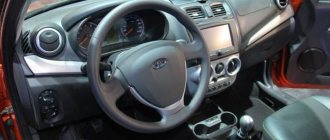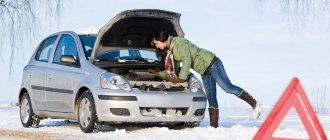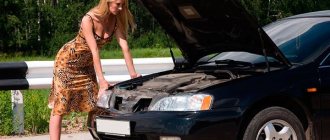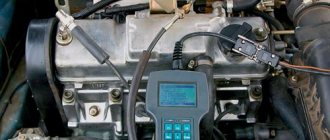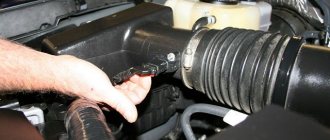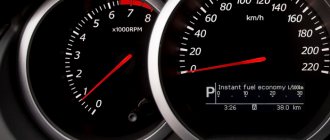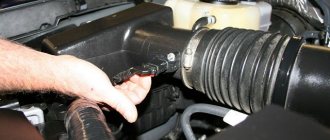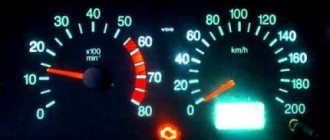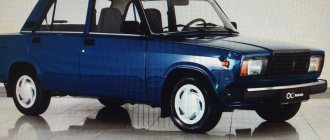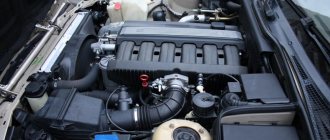What is "failure"? This is an effect in which the car does not accelerate when you press the gas pedal. Usually the failure lasts a few seconds, and then the “jerk” effect occurs. This is a fairly common malfunction associated with the fuel injection system. On Kalina, it does not occur often, but it does happen.
Video about gas failures on an injection engine:
This video material will talk about such a malfunction as gas leaks, the causes of occurrence, methods of elimination, and also contains some recommendations for car owners.
Drop in speed and failure of the gas pedal
There are few reasons for the phenomenon of “failure” when pressing the gas pedal. Often it appears after unsuccessful engine chip tuning and is accompanied by, but there are other problems directly with injection. So, let’s look at the main reasons for the “failure” effect:
- Injectors
. The fuel distribution system directly affects engine performance.Clogged injectors
- Damage to the injector
. - The fuel supply system
has failed . -
engine temperature and mixture enrichment sensors - Errors
in the electronic engine control unit.Identifying and eliminating ECU errors
- Spark plug
. This is the most common cause of accelerator pedal failure.Condition of the candles. On the left the mixture is too rich, on the right it is too lean.
These are all the main reasons that can lead to gas pedal failure.
Dips during acceleration
Once the causes are considered, we can consider how to deal with the problem. So, let’s describe step by step what needs to be done when the gas pedal has dips during acceleration:
- The first step is to check the spark plugs. The appearance of carbon deposits or spark plugs that are too clean indicate that the mixture is not adjusted correctly. It is worth adjusting the correct amount of fuel mixture.
- Ignition wires can also cause the vehicle to malfunction.
- A clogged throttle can lead to failures during acceleration.
- The condition of the air filter affects the formation of the mixture, so it is worth changing it on time.
Air filter clogged - The fuel pump (), as well as the condition of the fuel filter, can affect injection.
Therefore, in case of failures, it is necessary to diagnose them. To diagnose and check its operation, as well as the condition of the mesh filter. Dirty fuel filter - ECU errors can also lead to accelerator failures.
- The last reason is clogged injectors. They need to carry out diagnostics, check functionality, and also clean and replace faulty elements.
Thus, the causes of failures during overclocking have been identified and can be eliminated.
Gas leaks at idle
At idle, there are fewer reasons for failures, but they will have to be eliminated, since the car simply will not start normally, or stall after starting the engine. So, let's look at the work plan step by step:
- Checking the spark plugs. If the element fails, it is necessary to replace it.
Checking and adjusting the spark plug gap using a feeler gauge
All these reasons can cause dips to appear at idle (more precisely, when switching from idle to driving mode).
Other engine and system malfunctions
- Compression in the engine cylinders is low.
- The cylinder head gasket is damaged.
- The engine control system is faulty.
- The valves of the gas distribution mechanism are burnt out and leaky.
- The exhaust system is leaking.
- The valve clearances are not adjusted (8-valve engines only).
- The hydraulic pushers are faulty.
- The engine air filter is dirty.
- Vacuum hose connections are leaking.
Keywords: Lada Granta engine | Lada Priora engine | Lada Kalina engine | Lada Kalina 2 engine | Lada Largus engine | Lada Vesta engine | Niva engine | lada xray engine | universal article
Problems with the engine (troits, jerks, pulls poorly), causes
05 October 2015 LadaOnline 65 831 Does the car jerk at low speeds or when accelerating? Is the engine running rough and the Check Engine light on? Has the car lost its dynamics and doesn’t drive like before? In this article we will tell you about all the possible causes of these malfunctions and how to solve the problem.
It is worth noting that the causes of malfunctions are similar for all modern Lada cars (Kalina, Granta, Priora, Largus, Vesta, Niva or XRAY), because AvtoVAZ equips them with engines with identical characteristics.
It is recommended to start searching for a problem with diagnostics (reading errors). If this is not possible, then we first perform a test (or temporarily install a known working spare part/sensor), and only then replace the faulty parts.
If the engine idles or the car jerks when accelerating (driving), possible reasons:
Malfunctions in the fuel system
- The fuel filter or fuel line is clogged.
- The fuel injectors or their circuits are faulty.
- The fuel pump is faulty.
- The fuel pressure regulator (FPR) is not working.
You need to check the pressure in the fuel system.
Malfunctions of sensors or their circuits
- Crankshaft position sensor (CPS).
- Coolant temperature sensor (CTS).
- Throttle position sensor (TPS).
- Mass air flow sensor (MAF).
- Knock sensor (DS).
- Oxygen sensor (OS).
More details about sensors.
What's the result?
With that said, if the engine is not making power, it could be due to the ignition, air or fuel supply. We add that a decrease in engine power can also occur depending on external conditions: ambient temperature and atmospheric air pressure.
If the car pulls worse under certain conditions, then this is not a malfunction. For example, high in the mountains, the power of an engine, especially an atmospheric one, decreases. Also in the summer, in extreme heat, the fuel pump or carburetor may overheat.
As a result, I would like to remind you that the throughput of the intake and fuel system greatly depends on the condition of the fuel and air filters. For this reason, filter elements must be changed promptly to ensure maximum performance from the engine.
Reason 1. The food was so-so
The author of the article had a breathtakingly funny story. True, not with him personally, but with a friend. He once filled up with fuel at a well-known gas station. I filled it up and went on a date with the girl. And it’s frosty, winter outside. While we sat in the cafe and cooed at the cinema, it’s time to go home. But there’s no way to get home – the car doesn’t move. Well, no way at all: we haven’t tried everything, we haven’t read what forums. And so, on the advice of an experienced person, my friend decided to stick a branch into the gas tank and check the gasoline. And what do you think? Gasoline is frozen! That is, in general! Apparently the brave mixers overdid it with water in the fuel. Of course, they drove the car away, warmed it up and drained the gasoline, but a residue remained.
The quality of the fuel directly affects the behavior of the car. You can press the pedal to the floor as long and sharply as you like, but you will not achieve any effect. The car will sneeze, slow down and suffer along with you. The simplest thing is to drain the gasoline and pour 5 - 10 liters from another gas station. If this was the case, the symptoms will immediately disappear. And if it’s not in it, then pour the old one back in - don’t let the goodness go to waste. We wrote about the consequences of pouring low-quality fuel here.
Stuttering when accelerating? Dig! — logbook Lada Kalina Sedan 2006 on DRIVE2
As you know, every car requires attention. So mine demanded it. Sluggish acceleration, vibration, consumption, shocks when switching. List of suspects:1. MAF sensor. I recently measured www.drive2.ru/l/477094589040165062/. The multimeter reading is 1.04 V.
According to the diagnostics, it showed 1.016 V. There is a third way - remove the chip from the mass air flow sensor and drive it. I haven't tried it.
Full size
Mass air flow sensor 1.016 V.
2. Candles. I forgot to take a photo. Yesterday I took it off, like new. Candles cost 17 dv. www.drive2.ru/l/473344429755728085/. I'm going to install DENSO.
3. Air filter. Yesterday I took it out dirty. I blew it out from the compressor. I was breathing better. It was easier to go.
photo from the Internet. It looks like it was for me.
4. I have long wanted to try running antifreeze past the throttle valve. The fitting was used from an old radiator.
That's how I sawed it off.
did the same
5. Corrugation. www.drive2.ru/l/478326591819088066/. I've seen some cars come out inside. I thought so too. It turned out not. It just rattled and siphoned. Although sound could also play a role. After replacement the vibration went away.
Free passage
6. It remains to look at the injectors. There is no smell of gasoline. But the O-rings have already been purchased. I took washing for the injector and valves. I'll do it as soon as I fill the tank full. After this, you will need to replace the spark plugs as recommended.
Like this
7. Here I will simply post screenshots from the diagnostics. Guys who understand may notice. I'd be glad for your advice.
www.drive2.ru
Dips during acceleration
Once the causes are considered, we can consider how to deal with the problem. So, let’s describe step by step what needs to be done when the gas pedal has dips during acceleration:
- The first step is to check the spark plugs. The appearance of carbon deposits or spark plugs that are too clean indicate that the mixture is not adjusted correctly. It is worth adjusting the correct amount of fuel mixture.
- Ignition wires can also cause the vehicle to malfunction.
- A clogged throttle can lead to failures during acceleration.
- The condition of the air filter affects the formation of the mixture, so it is worth changing it on time.
Air filter clogged - The fuel pump (), as well as the condition of the fuel filter, can affect injection.
Therefore, in case of failures, it is necessary to diagnose them. To diagnose and check its operation, as well as the condition of the mesh filter. Dirty fuel filter - ECU errors can also lead to accelerator failures.
- The last reason is clogged injectors. They need to carry out diagnostics, check functionality, and also clean and replace faulty elements.
Thus, the causes of failures during overclocking have been identified and can be eliminated.
Causes of the phenomenon
Drop in speed and failure of the gas pedal
There are few reasons for the phenomenon of “failure” when pressing the gas pedal. It often appears after unsuccessful engine chip tuning and is accompanied by an increase in fuel consumption, but there are other problems directly with injection. So, let’s look at the main reasons for the “failure” effect:
- Injectors . The fuel distribution system directly affects engine performance.
Identifying and eliminating ECU errors
Condition of the candles. On the left the mixture is too rich, on the right it is too lean.
These are all the main reasons that can lead to gas pedal failure.
Dips during acceleration
Once the causes are considered, we can consider how to deal with the problem. So, let’s describe step by step what needs to be done when the gas pedal has dips during acceleration:
- The first step is to check the spark plugs. The appearance of carbon deposits or spark plugs that are too clean indicate that the mixture is not adjusted correctly. It is worth adjusting the correct amount of fuel mixture.
- Ignition wires can also cause the vehicle to malfunction.
- A clogged throttle can lead to failures during acceleration.
- The condition of the air filter affects the formation of the mixture, so it is worth changing it on time.
Air filter clogged
Dirty fuel filter
Dirty fuel filter
- ECU errors can also lead to accelerator failures.
- The last reason is clogged injectors. They need to carry out diagnostics, check functionality, and also clean and replace faulty elements.
Thus, the causes of failures during overclocking have been identified and can be eliminated.
Gas leaks at idle
At idle, there are fewer reasons for failures, but they will have to be eliminated, since the car simply will not start normally, or stall after starting the engine. So, let's look at the work plan step by step:
- Checking the spark plugs. If the element fails, it is necessary to replace it.
Attention! It is recommended to change all four spark plugs to ensure smooth engine operation. Before installation, you should adjust the gap using a feeler gauge, which should be 1 mm for 92 gasoline.
Checking and adjusting the spark plug gap using a feeler gauge
- We change the fuel filter, it is located under the bottom of the tank, and also carry out diagnostics on the fuel pump. If malfunctions are identified, they should be eliminated.
Clogged filter in the gasoline pump
All these reasons can cause dips to appear at idle (more precisely, when switching from idle to driving mode).
Dips when pressing the gas pedal Lada Kalina: acceleration and idling
What is "failure"? This is an effect in which the car does not accelerate when you press the gas pedal. Usually the failure lasts a few seconds, and then the “jerk” effect occurs. This is a fairly common malfunction associated with the fuel injection system. On Kalina, it does not occur often, but it does happen.
Video about gas failures on an injection engine:
This video material will talk about such a malfunction as gas leaks, the causes of occurrence, methods of elimination, and also contains some recommendations for car owners.
Causes of the phenomenon
Drop in speed and failure of the gas pedal
There are few reasons for the phenomenon of “failure” when pressing the gas pedal. It often appears after unsuccessful engine chip tuning and is accompanied by an increase in fuel consumption, but there are other problems directly with injection. So, let’s look at the main reasons for the “failure” effect:
These are all the main reasons that can lead to gas pedal failure.
Dips during acceleration
Once the causes are considered, we can consider how to deal with the problem. So, let’s describe step by step what needs to be done when the gas pedal has dips during acceleration:
Thus, the causes of failures during overclocking have been identified and can be eliminated.
Gas leaks at idle
At idle, there are fewer reasons for failures, but they will have to be eliminated, since the car simply will not start normally, or stall after starting the engine. So, let's look at the work plan step by step:
- Checking the spark plugs. If the element fails, it is necessary to replace it.
Checking and adjusting the spark plug gap using a feeler gauge
All these reasons can cause dips to appear at idle (more precisely, when switching from idle to driving mode).
conclusions
The main cause of failures are spark plugs, but they are not the only ones that influence the appearance of this effect. Some car enthusiasts may not be able to cope with the occurrence of such malfunctions on their own, and it is necessary to go to a car service center, where they will carry out high-quality diagnostics and also fix the problem. But it is worth considering that you will have to be generous, since neither computer diagnostics nor repairs will cost a penny.
carfrance.ru
THE VEHICLE MOVES JERKLY
In relation to a car, a jerk is a short-term spontaneous change in the engine crankshaft speed, regardless of the position of the gas pedal. In everyday use, as a rule, there are a series of jerks.
The extreme case of a jerk is a failure - a noticeable delay in the engine's response to pressing the accelerator pedal.
Conventionally, three types of jerks can be distinguished: - at the moment of movement; - during acceleration; - during steady movement, i.e. with the accelerator pedal in constant position.
To determine the causes of jerks when driving a car with an injection engine, special diagnostic equipment is required, so in this case we recommend contacting a car service center that specializes in repairing fuel injection systems. However, as practice shows, in most cases jerking is caused by insufficient fuel pressure in the engine fuel line (rail) or a malfunction of the throttle position sensor. With some skills, you can determine the cause of jerking yourself.
Jerking when the car starts moving
At the moment the movement begins, the limiting case of a jerk—failure—most often occurs. The most unpleasant sensations are associated precisely with the delay in the engine’s response to pressing the gas pedal. Sometimes the engine even stalls.
A jerk occurs at the moment the throttle valve begins to open, when, based on a signal from the throttle position sensor, the electronic control unit determines the moment of transition from idle mode to load mode and must increase the amount of fuel supplied through the injectors.
If the pressure in the fuel line is insufficient (even if the injection duration is increased), there is not enough fuel for a smooth start.
Jerking when accelerating a car
The cause of jerking during acceleration may be, as in the previous case, insufficient fuel pressure in the fuel line.
The electronic engine control unit, having received a signal from the throttle position sensor about the intensive opening of the damper at a large angle, strives to maximize the fuel supply, but due to the reduced fuel pressure it is not able to do this.
Jerks during steady vehicle movement
Such jerking is most often caused by a malfunction of the ignition system. Diagnosis and repair are required.
On the way, you can try to do the following yourself: - carefully inspect the engine compartment. Turn off the ignition and check the secure fastening and seating of all wires and connectors at the ignition coil and high-voltage wires.
Start the engine and listen to its operation: the crackling sound when the high voltage breaks down to ground is weak, but distinct. In complete darkness, the spark during breakdown is clearly visible;
— replace spark plugs regardless of their condition and mileage.
Pay attention to the condition of the spark plugs: if it is not up to standard, the engine or its systems may need to be repaired
A specific cause of jerking during steady motion of a car with an injection engine may be a failure of the throttle position sensor.
Additional symptoms confirming the malfunction of this sensor: - uneven operation of the engine at idle;
- reduction in maximum engine power.
Poor dynamics of the internal combustion engine due to the catalyst: how to check
The topic of a drop in dynamics due to a clogged catalyst deserves a separate paragraph. This malfunction has become very common among motorists lately; questions about this are often found on forums.
We will not delve into the thematic jungle regarding what a catalyst is and why it is needed. Let's consider only the main signs indicating its malfunction. And a drop in engine power is not the only symptom.
The main sign is, of course, the “Check” light that comes on. However, a malfunction of the catalyst is not always detected so easily; in most cases, it passes gradually, and the “Check” signal is not displayed immediately. But the throttle response of the internal combustion engine decreases, the overall dynamics of acceleration decreases and starting becomes more difficult.
Whether to remove the catalyst or not is the choice of the car owner, but it should be remembered that there is nothing “totally superfluous” in the car
The reason for the drop in power characteristics can also be a clogged reel honeycomb. Because of this, the throughput of the catalyst decreases, since gases that did not have time to pass through the catalyst “crush” the power of the power plant.
Note. The bobbin honeycombs can not only become clogged, but also collapse or melt over time.
Problems with the catalyst can also be associated with abrasion of the platinum layers. The lambda sensor instantly notices this and sends a signal to the driver.
You can check whether the catalyst is working normally or not by looking at the strength of the gas flow. If it is difficult to block the flow by hand, then everything is fine with the catalyst, but when it is clogged, the flow will be weak.
Causes of malfunction
General view of the engine
As in any car, in the Lada Kalina, jerking at low speeds is the first sign of a malfunction in one of the systems. Let's look at where the main problems arise:
- The fuel system and its components can cause the problem.
- The ignition system is associated with the fact that the car jerks at low speeds.
- Another reason could be the gearbox.
To more accurately determine the causes of the malfunction, it is worth considering each system and component separately.
Fuel system
The car jerks at low speeds - this may be due to the fact that the engine does not receive enough fuel mixture.
The problem may lie in the fuel system. In this case, you will have to examine several elements that are part of it.
Fuel rail and fuel injectors
Let's look at finding the problem step by step:
- The first place to look for a problem is the fuel rail and injectors . It is the poor condition of this unit that can cause the car to jerk when accelerating.
- The fuel pump, filter and lines can cause the driver to feel slight jolts at low speeds. For diagnostics, you will need to remove the fuel pump from the gas tank housing.
The mesh (strainer) in the fuel pump on a Lada Kalina is clogged
You can diagnose these components and parts yourself or contact a car service center.
Ignition
The ignition system can cause the car to jerk at low speeds. Particular attention should be paid to the ignition switch, in which the contact connections may fail.
A red glow plug removed from the engine
The second reason could be the spark plugs. Their serviceability and contamination can lead to the fact that the car will not only twitch at low speeds, but also work unstably in other ranges. To prevent this from happening, it is necessary to choose spark plugs with the required gap and recommended by the manufacturer.
Transmission
The most unpleasant consequence of the effect may be the gearbox. In this case, you will have to remove the gearbox, change the oil in it and add new oil to the level. And also carry out a complete disassembly of it for diagnostics. Thus, the reasons may be failed synchronizers of 1st and 2nd gears, wear of gears or shafts. Another problem can be bearings that are worn out.
Gearbox disassembled
Of course, you should trust the diagnosis of this unit to professionals at a car service center, but if possible, you can try to fix the malfunction on your own. Ultimately, when all else fails, they will always be happy to see you at the car service center.
Main causes of malfunctions
If there is no sound from the speakers, then the problem is not always a malfunction of the radio. The main problems are the following:
- Speaker failure. The main purpose of the device is to output sound. It is not always possible to carry out repairs yourself; often you have to completely replace the device. It is recommended to trust repairs to specialists.
- Problems with the amplifier. Often the car radio is connected to the speakers via an amplifier. Its purpose is to improve the quality of the outgoing signal. If the amplifier is not working properly, there will be no sound output from the speakers.
- Weakened contacts. If the radio turns on, but the sound of the car floats, there is a possibility of deterioration in the quality of the connection. Even the loosening of one contact can cause a malfunction of the entire system.
- The power circuit has closed. To power the radio, a power source is required; the lack of contact is caused by mechanical stress or corrosion due to high humidity.
- Inconsistency between the power of the used speaker system and the installed radio. Before you independently improve the acoustics in your car, you should consider the capabilities of the radio. If you choose the wrong equipment, it can overheat and fail. The amplifier is rarely repaired; most often it is replaced with a more suitable device.
The sound in the radio also disappears due to a malfunction of the device itself. It is not recommended to purchase fakes, as the Chinese model has poor build quality
Causes of malfunction
General view of the engine
As in any car, in the Lada Kalina, jerking at low speeds is the first sign of a malfunction in one of the systems. Let's look at where the main problems arise:
To more accurately determine the causes of the malfunction, it is worth considering each system and component separately.
Fuel system
The car jerks at low speeds - this may be due to the fact that the engine does not receive enough fuel mixture.
The problem may lie in the fuel system. In this case, you will have to examine several elements that are part of it.
Fuel rail and fuel injectors
Let's look at finding the problem step by step:
- The first place to look for a problem is the fuel rail and injectors . It is the poor condition of this unit that can cause the car to jerk when accelerating.
- The fuel pump, filter and lines can cause the driver to feel slight jolts at low speeds. For diagnostics, you will need to remove the fuel pump from the gas tank housing.
The mesh (strainer) in the fuel pump on a Lada Kalina is clogged
You can diagnose these components and parts yourself or contact a car service center.
Ignition
The ignition system can cause the car to jerk at low speeds. Particular attention should be paid to the ignition switch, in which the contact connections may fail.
A red glow plug removed from the engine
The second reason could be the spark plugs. Their serviceability and contamination can lead to the fact that the car will not only twitch at low speeds, but also work unstably in other ranges. To prevent this from happening, it is necessary to choose spark plugs with the required gap and recommended by the manufacturer.
Transmission
The most unpleasant consequence of the effect may be the gearbox. In this case, you will have to remove the gearbox, change the oil in it and add new oil to the level. And also carry out a complete disassembly of it for diagnostics. Thus, the reasons may be failed synchronizers of 1st and 2nd gears, wear of gears or shafts. Another problem can be bearings that are worn out.
Gearbox disassembled
Of course, you should trust the diagnosis of this unit to professionals at a car service center, but if possible, you can try to fix the malfunction on your own. Ultimately, when all else fails, they will always be happy to see you at the car service center.
No sound from speakers
There is often a situation where only one side plays. A common question among car enthusiasts is what to do in such a case. Most often, the problem is a faulty cable, which just needs to be cleaned accordingly. The following substances can be used for cleaning:
- Ethanol. It can be found in pharmacies, and the cost is relatively low.
- Isopropyl alcohol. This substance is much more expensive, is sold in large bottles, and cannot be used in the future to achieve other purposes.
- Nail polish remover. It is able to dissolve the smallest particles and also remove dust from the surface.
School eraser is used to clean large trains. Cleaning instructions are as follows:
- Use a Phillips screwdriver to remove the right trim in the immediate vicinity of the glove compartment.
- The screws that secure the torpedo trim are unscrewed.
- The front part of the radio is pulled out. It is often held on with clips.
- All connectors located at the rear are disconnected.
- The radio is disassembled, after which the cables are cleaned using a suitable substance.
After completing the above work, you can begin assembly in reverse order.
Dips when pressing the gas pedal Lada Kalina: acceleration and idling
What is "failure"? This is an effect in which the car does not accelerate when you press the gas pedal. Usually the failure lasts a few seconds, and then the “jerk” effect occurs. This is a fairly common malfunction associated with the fuel injection system. On Kalina, it does not occur often, but it does happen.
Video about gas failures on an injection engine:
This video material will talk about such a malfunction as gas leaks, the causes of occurrence, methods of elimination, and also contains some recommendations for car owners.
Causes of the phenomenon
Drop in speed and failure of the gas pedal
There are few reasons for the phenomenon of “failure” when pressing the gas pedal. It often appears after unsuccessful engine chip tuning and is accompanied by an increase in fuel consumption, but there are other problems directly with injection. So, let’s look at the main reasons for the “failure” effect:
These are all the main reasons that can lead to gas pedal failure.
Dips during acceleration
Once the causes are considered, we can consider how to deal with the problem. So, let’s describe step by step what needs to be done when the gas pedal has dips during acceleration:
Thus, the causes of failures during overclocking have been identified and can be eliminated.
Gas leaks at idle
At idle, there are fewer reasons for failures, but they will have to be eliminated, since the car simply will not start normally, or stall after starting the engine. So, let's look at the work plan step by step:
- Checking the spark plugs. If the element fails, it is necessary to replace it.
Checking and adjusting the spark plug gap using a feeler gauge
All these reasons can cause dips to appear at idle (more precisely, when switching from idle to driving mode).
conclusions
The main cause of failures are spark plugs, but they are not the only ones that influence the appearance of this effect. Some car enthusiasts may not be able to cope with the occurrence of such malfunctions on their own, and it is necessary to go to a car service center, where they will carry out high-quality diagnostics and also fix the problem. But it is worth considering that you will have to be generous, since neither computer diagnostics nor repairs will cost a penny.
carfrance.ru
Dips when pressing the gas pedal Lada Kalina: at idle or during acceleration
Drop in speed and failure of the gas pedal
There are few reasons for the phenomenon of “failure” when pressing the gas pedal. It often appears after unsuccessful engine chip tuning and is accompanied by an increase in fuel consumption, but there are other problems directly with injection. So, let’s look at the main reasons for the “failure” effect:
- Injectors. The fuel distribution system directly affects engine performance.
- Damage to the injector.
- The fuel supply system has failed.
- Wear of engine temperature and mixture enrichment sensors.
- Errors in the electronic engine control unit.
Identifying and eliminating ECU errors
Spark plug. This is the most common cause of accelerator pedal failure.
Condition of the candles. On the left the mixture is too rich, on the right it is too lean.
These are all the main reasons that can lead to gas pedal failure.
Reason 4. The pressure is so pressure
Look at the manual and decide what pressure is typical for the car. Find the regulator on the line and see if it is leaking. The second reason is incorrect configuration. Excess pressure is generated in the system, which affects the non-standard behavior of the car. Arm yourself with an air pump to check: raise the pressure level to the required level and dump fuel into the tank. The operations must be performed simultaneously. If fuel reset occurs earlier, the regulator should be replaced.
If you have an injection engine, look for the fuel pump in the gasoline tank. With a carburetor engine, the pump is located directly on the engine, under the hood.
BB wires
If the engine stalls at idle, the problem may be related to the operation of the ignition system. The culprit is the armored wires, which most often fail. If the wire is damaged, then the spark will break through and, naturally, there will be no spark at the spark plug. The fuel mixture in the cylinder will not ignite. It is best to check the wires with a multimeter.
Among the malfunctions of the wires, one can identify problems with the contacts at the points of connection with the spark plugs or with the coil. Also, the conductor may have various damages. If the insulation is destroyed, this will be accompanied by breakdowns and current leakage. In addition, increased wire resistance is also considered a malfunction. This also negatively affects sparking and the operation of the ignition system.
THE VEHICLE MOVES JERKLY
In relation to a car, a jerk is a short-term spontaneous change in the engine crankshaft speed, regardless of the position of the gas pedal. In everyday use, as a rule, there are a series of jerks.
The extreme case of a jerk is a failure - a noticeable delay in the engine's response to pressing the accelerator pedal.
Conventionally, three types of jerks can be distinguished: - at the moment of movement; - during acceleration; - during steady movement, i.e. with the accelerator pedal in constant position.
To determine the causes of jerks when driving a car with an injection engine, special diagnostic equipment is required, so in this case we recommend contacting a car service center that specializes in repairing fuel injection systems. However, as practice shows, in most cases jerking is caused by insufficient fuel pressure in the engine fuel line (rail) or a malfunction of the throttle position sensor. With some skills, you can determine the cause of jerking yourself.
Jerking when the car starts moving
At the moment the movement begins, the limiting case of a jerk—failure—most often occurs. The most unpleasant sensations are associated precisely with the delay in the engine’s response to pressing the gas pedal. Sometimes the engine even stalls.
A jerk occurs at the moment the throttle valve begins to open, when, based on a signal from the throttle position sensor, the electronic control unit determines the moment of transition from idle mode to load mode and must increase the amount of fuel supplied through the injectors.
If the pressure in the fuel line is insufficient (even if the injection duration is increased), there is not enough fuel for a smooth start.
Jerking when accelerating a car
The cause of jerking during acceleration may be, as in the previous case, insufficient fuel pressure in the fuel line.
The electronic engine control unit, having received a signal from the throttle position sensor about the intensive opening of the damper at a large angle, strives to maximize the fuel supply, but due to the reduced fuel pressure it is not able to do this.
Jerks during steady vehicle movement
Such jerking is most often caused by a malfunction of the ignition system. Diagnosis and repair are required.
On the way, you can try to do the following yourself: - carefully inspect the engine compartment. Turn off the ignition and check the secure fastening and seating of all wires and connectors at the ignition coil and high-voltage wires.
Start the engine and listen to its operation: the crackling sound when the high voltage breaks down to ground is weak, but distinct. In complete darkness, the spark during breakdown is clearly visible;
— replace spark plugs regardless of their condition and mileage.
Pay attention to the condition of the spark plugs: if it is not up to standard, the engine or its systems may need to be repaired
A specific cause of jerking during steady motion of a car with an injection engine may be a failure of the throttle position sensor.
Additional symptoms confirming the malfunction of this sensor: - uneven operation of the engine at idle;
- reduction in maximum engine power.
Why is there no sound on the radio?
If the radio is working but there is no sound, then the reasons are zero volume level or problems with the amplifier chip. In the first case, a malfunction of the general or sound settings of the car radio could occur.
When the car audio system is turned on at high volume in such a situation, the amplifier chip quickly burns out and the sound disappears. The reason why the sound in the car floats when the car radio is working is not always related to the settings or electrics. Interruptions when listening to music are often associated with defective media: flash drives, CDs and cassettes.
conclusions
The main cause of failures are spark plugs, but they are not the only ones that influence the appearance of this effect. Some car enthusiasts may not be able to cope with the occurrence of such malfunctions on their own, and it is necessary to go to a car service center, where they will carry out high-quality diagnostics and also fix the problem. But at the same time, it is worth considering that you will have to be generous, since neither the repair nor the repair will cost a penny.
Now a little background:
The car was purchased new in 2005, initially the engine seemed “strangled”. But without paying attention to this, they referred to the reason for its Euro-3 environmental class (it was not possible to compare engine dynamics at that time). We traveled like this for several years. By that time, the engine was becoming less dynamic, and citing its mileage (50-70 t.km.), they decided that the catalyst had definitely melted. Having heard enough stories about how easy it is to get rid of it, we didn’t take one thing into account :) If everything were that simple, it turned out to be metal
, not ceramic))). How we got rid of it is a separate story, but the result was still achieved. We start the engine, move off and... OH GOD! its dynamics have not changed in any way, only it has become louder (((( Around the same time, another malfunction appeared: the engine began to get hot during operation (high-quality antifreeze was used since the car was in operation!!). Now it not only does not pull , and it’s also heating up. The next struggle began with the second malfunction. The temperature sensor was replaced, then the pump, then the thermostat, then the temperature sensor again, and then the radiator itself. All this lasted for a year. Then we decided that the increased the operating temperature of the engine is a side effect of its first malfunction. Are the marks off? No, everything is normal. Again, all efforts were thrown into searching for the first cause. The next step was to change the engine program to the Euro-2 class. We set off - zero result! ... We continue to drive Over time, the dynamics of the car became comparable to a car loaded with 3, 4, 5, 10 bags of potatoes, and then it felt like you were towing a car. The mileage was already 100-130 t.km. It's time to change the fuel pump grid - zero results, then the fuel pump - zero results, cleaning the injectors - the same story. I am already silent about how many diagnostics have been made since operation. The parameters are always normal, and to the question “why doesn’t it work?” There are no exact answers. “Try changing this, doing that, checking the marks.” Like a fool, I’ve been checking my timing marks almost every month for several years now - in case they suddenly go wrong? If only I had known earlier what result this troubleshooting would lead to (What’s most interesting is that all the repairs done were typical for the operation of a LADA car, but only now I understand that most of them were in vain. Perhaps I would have continued to drive like this, so Only last week the car stopped moving at all. It accelerates only at a quarter of the gas and then in a straight line, and when starting from a stop uphill, where you need to give more gas, it completely choke (it hums and goes 1-2 km/h).
Maybe there are GURUs and SENSEIs among you who can tell you what the reason is?
PS I have extensive experience in operating the domestic automobile industry, and I myself am a mechanic by profession, I thought that LADA cars had been studied inside and out. He practically did the repairs himself, and the signs seemed to be characteristic. BUT THIS CASE BROUGHT ME TO my KNEES.
Dips when pressing the gas pedal Lada Kalina: at idle or during acceleration
Drop in speed and failure of the gas pedal
There are few reasons for the phenomenon of “failure” when pressing the gas pedal. It often appears after unsuccessful engine chip tuning and is accompanied by an increase in fuel consumption, but there are other problems directly with injection. So, let’s look at the main reasons for the “failure” effect:
- Injectors. The fuel distribution system directly affects engine performance.
Identifying and eliminating ECU errors
Spark plug. This is the most common cause of accelerator pedal failure.
Condition of the candles. On the left the mixture is too rich, on the right it is too lean.
These are all the main reasons that can lead to gas pedal failure.
Once the causes are considered, we can consider how to deal with the problem. So, let’s describe step by step what needs to be done when the gas pedal has dips during acceleration:
- The first step is to check the spark plugs. The appearance of carbon deposits or spark plugs that are too clean indicate that the mixture is not adjusted correctly. It is worth adjusting the correct amount of fuel mixture.
- Ignition wires can also cause the vehicle to malfunction.
- A clogged throttle can lead to failures during acceleration.
- The condition of the air filter affects the formation of the mixture, so it is worth changing it on time.
Air filter clogged
The fuel pump (main faults), as well as the condition of the fuel filter, can affect injection. Therefore, in case of failures, it is necessary to diagnose them. To diagnose, you need to remove the fuel pump and check its operation, as well as the condition of the mesh filter.
Dirty fuel filter
Dirty fuel filter
